Austrian Nora Gregor (1901-1949) was an operetta diva and a stage and film actress. Her most famous screen role was Christine de la Chesnaye in Jean Renoir's classic film La Règle du Jeu (1939). She worked briefly in Hollywood during the early talkie era, appearing in foreign-language versions of MGM productions.
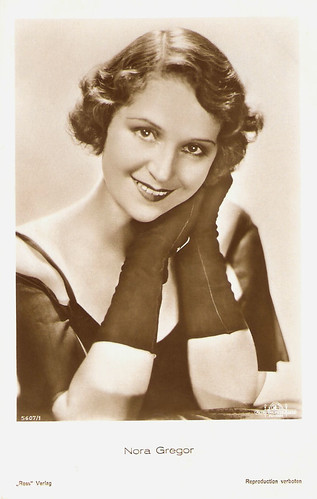
German postcard by Ross Verlag, no. 5607/1, 1930-1931. Photo: Metro-Goldwyn-Mayer (MGM).
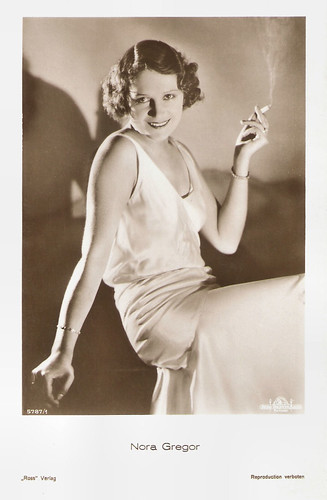
German postcard by Ross Verlag, no. 5787/1, 1930-1931. Photo: Metro-Goldwyn-Mayer.

Austrian postcard by Iris Verlag, no. 6112. Distributed in Italy by Casa Editrice Ballerini & Fratini, Firenze. Photo: Metro-Goldwyn-Mayer.

French postcard by Europe, no. 85E. Photo: Metro-Goldwyn-Mayer.
Nora Gregor was born in 1901 as Eleonora Hermina Gregor in Görz (Gorizia) in former Austria-Hungary (now Italy) to Austrian Jewish parents. She made her stage debut in an operetta in Graz, Austria. From there she went to the Volksbühne an das Raimund-Theater in Vienna.
Her first silent film was Gefesselt/Tied Up (Peter Paul Felner, 1920). Other early Austrian films were Die Schauspielerin des Kaisers/The Actress of the Emperor (Hans Otto, 1921) and Meriota, die Tänzerin/Meriota, the Dancer (Julius Herska, 1921), in which she played Lucrezia Borgia. She continued her film career successfully with Die Venus/The Venus (Hans Homma, 1922) with Magda Sonja, and Die kleine Sünde/The Small Sin (Julius Herska, 1923).
With her role as the aristocratic femme fatale Princess Zamikoff in Michael/Chained: The Story of the Third Sex (1924), directed by Danish director Carl Theodor Dreyer, she achieved her first great success. This groundbreaking film tells the story of a bisexual love triangle with Benjamin Christensen and Walter Slezak as the other angles. After this international breakthrough, she appeared in such German productions as Das Mädchen mit dem Protektion/The Girl with the Patronage (Max Mack, 1925) with Ossi Oswalda, Der Geiger von Florenz/The Violinist of Florence (Paul Czinner, 1926) with Elisabeth Bergner and Conrad Veidt, and Eheskandal im Hause Fromont jun. und Risler sen./Marriage Scandal in the House Fromont jun. and Risler sen. (A.W. Sandberg, 1927) with Lucy Doraine.
MGM contracted Nora Gregor but while she arrived in Hollywood the talkie replaced the silent film. She had a short appearance in The Hollywood Revue of 1929 (Charles Reisner, 1929). She played the leading role in Olympia (Jacques Feyder, 1930), the German language version of His Glorious Night (Lionel Barrymore, 1930). She made a short excursion to Germany, where she starred with Harry Liedtke in Und das ist die Hauptsache/That's All That Matters (Joe May, 1931) and then she returned to Hollywood for more alternate language versions of MGM productions.
She appeared in Mordprozess Mary Dugan/The Trial of Mary Dugan (Arthur Robison, 1931) and together with Paul Morgan, Dita Parlo and Buster Keaton in Wir schalten um auf Hollywood/We Switch Over to Hollywood (Frank Reicher, 1931). She also played in the English-spoken But the Flesh Is Weak (Jack Conway, 1932) with Robert Montgomery, based on a stage hit by Ivor Novello. Then she returned to Europe.

Dutch postcard, no. 17. Photo: Metro-Goldwyn-Mayer. Publicity still for Mordprozess Mary Dugan (Arthur Robison, 1931).
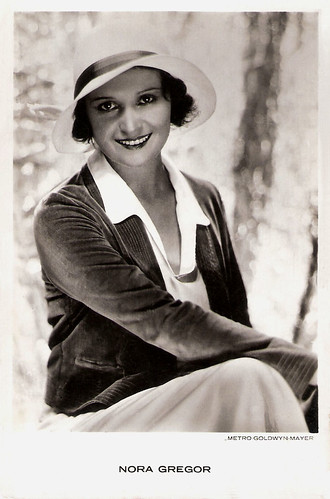
Dutch postcard. Sent by mail in 1932. Photo: Metro-Goldwyn-Mayer.
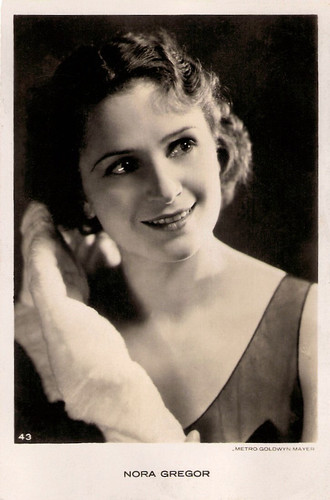
Dutch postcard by JosPé, Arnhem, no. 43. Photo: Metro-Goldwyn-Mayer.
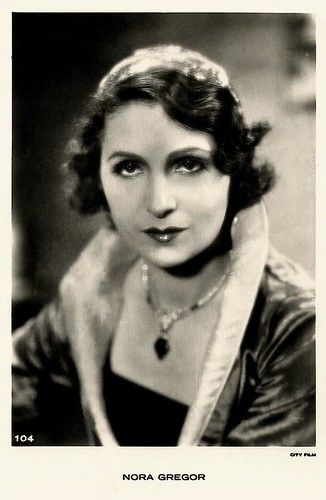
Dutch postcard by City Film, no. 104.
In Germany, Nora Gregor played in Abenteuer am Lido/Adventure at the Lido (Richard Oswald, 1933) and opposite Peter Lorre in the entertaining comedy Was Frauen träumen/What Women Dream (Géza von Bolvary, 1933), based on a script by Billy Wilder. The next years she worked at the Max Reinhardt Bühne in Berlin and at the Burgtheater in Vienna, where she played Desdemona in 'Othello' and Juliet in 'Romeo and Juliet' by William Shakespeare.
In 1937, after divorcing pianist Mitja Nikisch, she married Prince Ernst Ruediger von Starhemberg, vice chancellor of Austria and nationalist and conservative politician. After the Anschluss by the Nazis in 1938, they had to flee from Austria and emigrated through Switzerland to France. There, her husband joined the Free French forces. Cut off from their money and the eighty family estates, they were supported for a period by Starhemberg's close friend Friedrich Mandl, the Austrian armaments magnate and former husband of Hedy Lamarr.
In France, Nora Gregor made only one film, the brilliant, black comedy La Règle du Jeu/The Rules of the Game (Jean Renoir, 1938). This controversial film was Renoir's look at bourgeois life in France at the onset of World War II. At French Films, James Travers writes: "Although La Régle du jeu is now safely acknowledged as one of the greatest films in cinema history, it has certainly had a chequered history. The film was, at the time it was made, one of Renoir’s most ambitious films, costing around five million Francs, but it was a commercial disaster. (...) It was condemned by critics and the public alike for its scandalous and depressing tone. Under the occupation during World War II, the film was banned and soon disappeared into obscurity. The film resurfaced in the late 1950s, having been fully restored (under Renoir’s supervision), and following its showing at the Venice Film Festival in 1959 it was instantly established as one of the genuine masterpieces of world cinema."
This was to be Nora Gregor's last appearance in the European cinema. WW II forced her and her husband in 1942 to go into exile again and this time they went to Argentina and Chile. Her last appearance was in the Chilean-French film La Fruta mordida/The Bitten Fruit (Jacques Rémy, 1945). Reportedly depressed since the beginning of her South American exile, she committed suicide in Viña del Mar, Chile (some sources say Santiago de Chile) in 1949. Her son Heinrich Starhemberg (1934-1997) was also an actor, often credited as Henry Gregor.
Scene from Michael/Chained: The Story of the Third Sex (1924). Source: RADIOSANTOS (YouTube).
Scene from Was Frauen träumen/What Women Dream (1933) with Peter Lorre and Nora Gregor.
Trailer of La Règle du Jeu/The Rules of the Game (1938). Source: Janusfilms (YouTube).
Sources: Thomas Staedeli (Cyranos), Hal Erickson (AllMovie - page now defunct), James Travers (French Films), Rudi Polt (IMDb), Wikipedia, and IMDb.
This post was last updated on 12 July 2024.

German postcard by Ross Verlag, no. 5607/1, 1930-1931. Photo: Metro-Goldwyn-Mayer (MGM).

German postcard by Ross Verlag, no. 5787/1, 1930-1931. Photo: Metro-Goldwyn-Mayer.

Austrian postcard by Iris Verlag, no. 6112. Distributed in Italy by Casa Editrice Ballerini & Fratini, Firenze. Photo: Metro-Goldwyn-Mayer.

French postcard by Europe, no. 85E. Photo: Metro-Goldwyn-Mayer.
Groundbreaking film
Nora Gregor was born in 1901 as Eleonora Hermina Gregor in Görz (Gorizia) in former Austria-Hungary (now Italy) to Austrian Jewish parents. She made her stage debut in an operetta in Graz, Austria. From there she went to the Volksbühne an das Raimund-Theater in Vienna.
Her first silent film was Gefesselt/Tied Up (Peter Paul Felner, 1920). Other early Austrian films were Die Schauspielerin des Kaisers/The Actress of the Emperor (Hans Otto, 1921) and Meriota, die Tänzerin/Meriota, the Dancer (Julius Herska, 1921), in which she played Lucrezia Borgia. She continued her film career successfully with Die Venus/The Venus (Hans Homma, 1922) with Magda Sonja, and Die kleine Sünde/The Small Sin (Julius Herska, 1923).
With her role as the aristocratic femme fatale Princess Zamikoff in Michael/Chained: The Story of the Third Sex (1924), directed by Danish director Carl Theodor Dreyer, she achieved her first great success. This groundbreaking film tells the story of a bisexual love triangle with Benjamin Christensen and Walter Slezak as the other angles. After this international breakthrough, she appeared in such German productions as Das Mädchen mit dem Protektion/The Girl with the Patronage (Max Mack, 1925) with Ossi Oswalda, Der Geiger von Florenz/The Violinist of Florence (Paul Czinner, 1926) with Elisabeth Bergner and Conrad Veidt, and Eheskandal im Hause Fromont jun. und Risler sen./Marriage Scandal in the House Fromont jun. and Risler sen. (A.W. Sandberg, 1927) with Lucy Doraine.
MGM contracted Nora Gregor but while she arrived in Hollywood the talkie replaced the silent film. She had a short appearance in The Hollywood Revue of 1929 (Charles Reisner, 1929). She played the leading role in Olympia (Jacques Feyder, 1930), the German language version of His Glorious Night (Lionel Barrymore, 1930). She made a short excursion to Germany, where she starred with Harry Liedtke in Und das ist die Hauptsache/That's All That Matters (Joe May, 1931) and then she returned to Hollywood for more alternate language versions of MGM productions.
She appeared in Mordprozess Mary Dugan/The Trial of Mary Dugan (Arthur Robison, 1931) and together with Paul Morgan, Dita Parlo and Buster Keaton in Wir schalten um auf Hollywood/We Switch Over to Hollywood (Frank Reicher, 1931). She also played in the English-spoken But the Flesh Is Weak (Jack Conway, 1932) with Robert Montgomery, based on a stage hit by Ivor Novello. Then she returned to Europe.

Dutch postcard, no. 17. Photo: Metro-Goldwyn-Mayer. Publicity still for Mordprozess Mary Dugan (Arthur Robison, 1931).

Dutch postcard. Sent by mail in 1932. Photo: Metro-Goldwyn-Mayer.

Dutch postcard by JosPé, Arnhem, no. 43. Photo: Metro-Goldwyn-Mayer.

Dutch postcard by City Film, no. 104.
Eighty family estates
In Germany, Nora Gregor played in Abenteuer am Lido/Adventure at the Lido (Richard Oswald, 1933) and opposite Peter Lorre in the entertaining comedy Was Frauen träumen/What Women Dream (Géza von Bolvary, 1933), based on a script by Billy Wilder. The next years she worked at the Max Reinhardt Bühne in Berlin and at the Burgtheater in Vienna, where she played Desdemona in 'Othello' and Juliet in 'Romeo and Juliet' by William Shakespeare.
In 1937, after divorcing pianist Mitja Nikisch, she married Prince Ernst Ruediger von Starhemberg, vice chancellor of Austria and nationalist and conservative politician. After the Anschluss by the Nazis in 1938, they had to flee from Austria and emigrated through Switzerland to France. There, her husband joined the Free French forces. Cut off from their money and the eighty family estates, they were supported for a period by Starhemberg's close friend Friedrich Mandl, the Austrian armaments magnate and former husband of Hedy Lamarr.
In France, Nora Gregor made only one film, the brilliant, black comedy La Règle du Jeu/The Rules of the Game (Jean Renoir, 1938). This controversial film was Renoir's look at bourgeois life in France at the onset of World War II. At French Films, James Travers writes: "Although La Régle du jeu is now safely acknowledged as one of the greatest films in cinema history, it has certainly had a chequered history. The film was, at the time it was made, one of Renoir’s most ambitious films, costing around five million Francs, but it was a commercial disaster. (...) It was condemned by critics and the public alike for its scandalous and depressing tone. Under the occupation during World War II, the film was banned and soon disappeared into obscurity. The film resurfaced in the late 1950s, having been fully restored (under Renoir’s supervision), and following its showing at the Venice Film Festival in 1959 it was instantly established as one of the genuine masterpieces of world cinema."
This was to be Nora Gregor's last appearance in the European cinema. WW II forced her and her husband in 1942 to go into exile again and this time they went to Argentina and Chile. Her last appearance was in the Chilean-French film La Fruta mordida/The Bitten Fruit (Jacques Rémy, 1945). Reportedly depressed since the beginning of her South American exile, she committed suicide in Viña del Mar, Chile (some sources say Santiago de Chile) in 1949. Her son Heinrich Starhemberg (1934-1997) was also an actor, often credited as Henry Gregor.
Scene from Michael/Chained: The Story of the Third Sex (1924). Source: RADIOSANTOS (YouTube).
Scene from Was Frauen träumen/What Women Dream (1933) with Peter Lorre and Nora Gregor.
Trailer of La Règle du Jeu/The Rules of the Game (1938). Source: Janusfilms (YouTube).
Sources: Thomas Staedeli (Cyranos), Hal Erickson (AllMovie - page now defunct), James Travers (French Films), Rudi Polt (IMDb), Wikipedia, and IMDb.
This post was last updated on 12 July 2024.
No comments:
Post a Comment